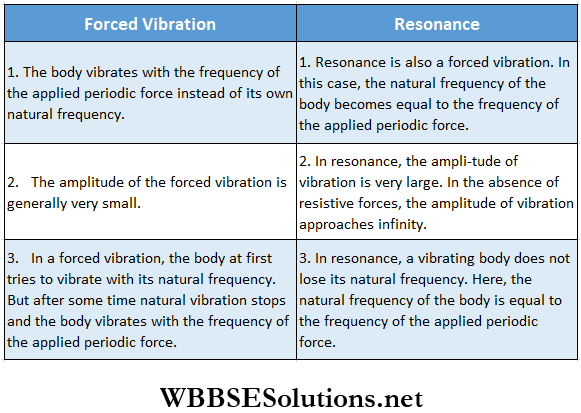Nature Of Vibration – Free Or Natural Vibration
A vibrating body always moves to and fro about an equilibrium position. At the instant when it is at the equilibrium position, there are no forces acting on the body. However, the body does not stop because of its inertia of motion.
As soon as it crosses the equilibrium position, a force acts on it. This force is always directed toward the equilibrium position and is called the restoring force.
If no force other than the restoring force acts on the body, or the effect of other forces is negligible, the body can vibrate without interruption, i.e., its vibration is a free or natural vibration. The amplitude of this vibration remains unchanged with the passage of time.
Free Or Natural Vibration Definition: If the effect of forces other than the restoring force is negligible on a vibrating body, its motion is called a free or natural vibration.
A body undergoing free vibration has a definite frequency, i.e., the body executes a fixed number of vibrations in unit time. It is called its natural frequency. The natural frequency (n0) depends on the density, shape elasticity, etc. of the vibrating body. For example:
A simple pendulum: \(n_0=\frac{1}{T}=\frac{1}{2 \pi} \sqrt{\frac{g}{L}}\); so if g is constant, the natural frequency of a simple pendulum depends on its length L.
An elastic spring: \(n_0=\frac{1}{T}=\frac{1}{2 \pi} \sqrt{\frac{k}{m}}\) = here the spring constant k is related to the elasticity of the material of the spring.
It may be said that the natural frequency of the spring depends on the mass (m) hanging at the end of the spring and the elasticity of the material of the spring. Every vibrating body such as a tuning fork, the string of a musical instrument, etc. has its characteristic natural frequency.
Nature Of Vibration – Damped Vibration
Damped Vibration Definition: If resistive forces act on a vibrating body in addition to the restoring force, its amplitude gradually diminishes. After some time, the body comes to rest at its position of equilibrium. This type of vibration is called damped vibration. The resistive effect is called damping.
- In fact, free vibration does not exist in real life. All vibrating bodies ultimately come to rest after some time, i.e., all vibrations are damped. Different types of resistive forces act on different types of vibrating bodies.
- For a simple pendulum, the resistive force is the viscous force of air; in a moving coil galvanometer, the resistive force is electromagnetic damping. The vibrating body has to work against these resistive forces. So its energy decreases. When the energy of the body becomes zero, it comes to rest.
Graphical representation of free and damped vibration: The characteristics of free and damped vibrations can be understood easily with the help of displacement time graphs. If the vibration of a body is free, it will vibrate forever with its amplitude unchanged. In real life, the amplitude gradually diminishes and ultimately the body comes to rest.
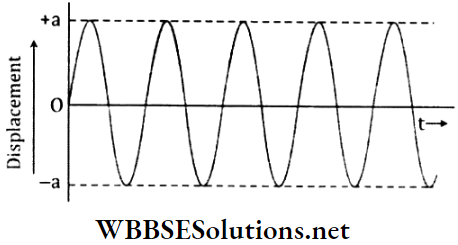
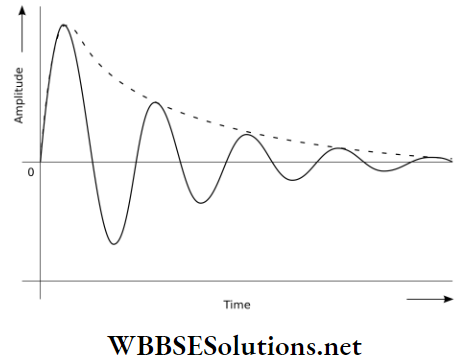
Beneficial examples of damped vibration: Damping plays a beneficial role in our modern-day life. One such application of damped oscillation is the car suspension system. It makes use of damping to make our ride less bumpy and more comfortable by counteracting and hence reducing the vibrations of the car when it is on the road for optimal passenger comfort, the system is critically damped or slightly underdamped.
Different types of damped motion:
1. If the damping is very weak, the body vibrates with almost its natural frequency. For example, if the bob of the simple pendulum is heavy enough, then the damping becomes insignificant. So the pendulum continues to oscillate for a long time. The time period and frequency of such a pendulum are almost equal to those of a free pendulum.
2. If the damping is stronger, the vibration of a body does not continue for a long time. For example, if a light piece of wood is used as the bob of a simple pendulum and is allowed to oscillate, it comes to rest after a few oscillations. In this case the time period becomes very large, i.e., the frequency of vibration is much less than the natural frequency.
3. In case of very strong damping, the vibrating body comes back to its position of equilibrium from its displaced position and stops there. So the body cannot move past its position of equilibrium. The body does not vibrate at all. This is called overdamped motion or aperiodic motion.
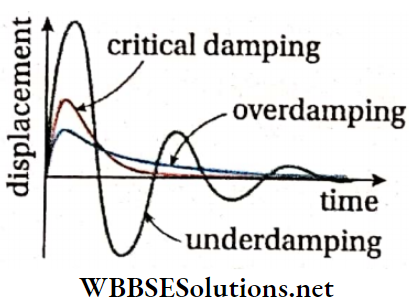
4. There is a particular state of damping, between small damping and overdamping, for which the body returns to its equilibrium position in the least time, but cannot travel past its position of equilibrium. This is called critical damping, In practical cases, if we want to stop the vibration of a body quickly, its damping is kept close to the state of critical damping.
5. If the damping is less than critical damping, the body oscillates with decreasing amplitude. This is known as underdamping.
Decrement of amplitude In damped vibration: From the graph for damped vibration we get, A1 = initial amplitude of vibration, A2 = amplitude of vibration after one complete oscillation, A3 = amplitude of vibration after two complete oscillations.
Obviously, A1 > A2 > A3
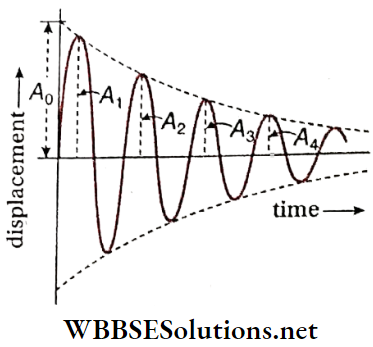
Two important characteristics of such a damped vibration are:
1. The amplitude of vibration decreases in a constant ratio for each complete vibration.
That is, \(\frac{A_1}{A_2}\)=\(\frac{A_2}{A_3}\)=\(\frac{A_3}{A_4}\)=\(\cdots\) = constant. This constant is called the decrement.
2. From the very initiation of motion, damping comes into play. Therefore, even the first amplitude A1 of damped vibration is less than the amplitude A0 of free vibration.
Equation of motion: A particle under damped har-monic vibration in one dimension is subject to two types of forces:
A restoring force: F1 = -kx, where k is constant.
One or more resistive forces: Each resistive force is proportional to the velocity \(\left(v=\frac{d x}{d t}\right)\)of the particle, and acts in a direction opposite to that of the instantaneous velocity.
So, the resultant of the resistive forces is, \(F_2=-k^{\prime} v=-k^{\prime} \frac{d x}{d t}\), where k’ is another constant.
The acceleration of the particle is, \(a=\frac{d v}{d t}=\frac{d^2 x}{d t^2}\). Thus from the relation F = ma, we get, ma = F1 + F2
or, \(m \frac{d^2 x}{d t^2}=-k x-k^{\prime} \frac{d x}{d t}\)
or, \(m \frac{d^2 x}{d t^2}+k^{\prime} \frac{d x}{d t}+k x=0\)
or, \(\frac{d^2 x}{d t^2}+2 b \frac{d x}{d t}+\omega^2 x=0\)
Were, \(\omega=+\sqrt{\frac{k}{m}} and b=\frac{k^{\prime}}{2 m}\),
The equation (1) is known as the equation of motion of a damped SHM.
Nature Of Vibration – Damped Vibration Numerical Examples
Example 1. A second pendulum is shifted 4 cm away from its equilibrium position and then released. After 2 s the pendulum is 3 cm away from its position of equilibrium. What will be the position of the pendulum after another 2s?
Solution:
Time period of a second pendulum is 2s. In the case of this damped vibration, let the change in the time period be negligible. For the given pendulum the initial amplitude of vibration A1 = 4 cm. After one complete oscillation, the amplitude of vibration A2 = 3 cm.
So, if the amplitude of vibration after two complete oscillations is A3, then the decrement is:
⇒ \(\frac{A_1}{A_2}=\frac{A_2}{A_3} \text { or, } A_3=\frac{\left(A_2\right)^2}{A_1}=\frac{(3)^2}{4}=2.25 \mathrm{~cm} \text {. }\)
Example 2. After 100 complete oscillations, a pendulum’s amplitude becomes 1/3 rd of its initial value. What will be its amplitude after 200 complete oscillations? Express it as a fraction of the initial amplitude.
Solution:
The pendulum has a damped vibration. So, the amplitude decreases at the same rate. Since, after 100 complete oscillations the amplitude of vibration becomes 1/3 rd of the initial amplitude, after 200 complete oscillations, the amplitude will be 1/3 x 1/3 = 1/9 th of the initial amplitude.
Nature Of Vibration – Forced Vibration
Practically all vibrations are damped vibration. The vibrating body works against different resistive forces. So its energy diminishes and the amplitude gradually decreases.
- To maintain a steady vibration, energy from an external source is needed. If energy is supplied from an external source in such a way that the rate of supply of energy exactly balances the rate of loss of energy, then the amplitude of the body remains constant.
- The value of the amplitude is similar to that of the free vibration of the body. This type of vibration is called a forced vibration. For example, if we do not wind a pendulum clock, it will stop after a while due to damping.
- When we wind the clock, we compress a spring within the clock which stores potential energy and supplies that energy continuously. The pendulum oscillates continuously with constant amplitude and time period.
External means are required not only for maintaining the vibration but also to vibrate a body that is initially at rest.
Examples of forced vibration:
1. If we strike a prong of a tuning fork, the intensity of the emitted sound is not very high so it cannot be heard from a distance. Now, if the handle of the vibrating tuning fork is made to touch the surface of a table, the tuning fork sets the table surface into forced vibration. Sound is emitted from the table also. Hence, the sound is amplified.
- It must be kept in mind that, according to the principle of conservation of energy, the total amount of energy cannot be increased. When the handle of the tuning fork is pressed against a table surface, a part of the energy from the tuning fork is transferred to the table.
- As the damping of the table is higher than that of the tuning fork, the energy transferred to the table by the tuning fork decays at a faster rate. Hence, the vibration of the table stops earlier and the intensity of the sound produced due to vibration of the table is comparatively higher.
- In this example of forced vibration, the upper surface of the table is made to vibrate by the tuning fork. The vibration of the tuning fork is the driving vibration and the vibration of the upper surface of the table is the driven vibration.
2. A thread is tied loosely between P and Q. Two pendulums C and D, having different lengths, are sus¬pended from two points between P and Q. If the pen¬dulum C is made to oscillate, it will continue its oscillation with its natural frequency. As the thread PQ is tied loosely, energy will be transferred from pendulum C to pendulum D through the thread.
- As a result, the pendulum D will begin to oscillate. As the lengths of the pendulums are different, their natural frequencies are not the same. It is found that the pen¬dulum D initially tries to oscillate at its natural frequency.
- But its vibration is damped quickly. Then pendulum D begins to oscillate at the natural frequency of C. In this example, pendulum C provides the driving vibration and the vibration of pendulum D is the driven vibration.
- In these two examples, it is to be noted that the external driving forces are neither steady nor momentary. Rather, the force originating from the vibrating body is a periodic force. In fact, the spring of a clock exerts a periodic force on the pendulum.
From the above discussions forced vibration can be defined in the following way.
Forced Vibration Definition: If an external periodic force is applied to a freely vibrating body, the body tries to maintain its vibrations at its own frequency; but after some time, the body begins to vibrate with the frequency of the applied periodic force. Such a vibration of a body is called a forced vibration.
Equation Of motion: A particle under forced harmonic vibration in one dimension is subject to three types of forces:
A restoring force: F1 = -kx, where k is constant.
Resistive forces: The resultant of all the resistive forces acting on a particle is, \(F_2=-k^{\prime} v=-k^{\prime} \frac{d x}{d t}\)
where v is the velocity of the particle and k’ is a constant.
Externally impressed periodic force: This is of the form, \(F_3=F_0 \sin \omega t\)
where ω is the circular frequency and F0 is the amplitude of the periodic force; both ω and F0 are constants.
The acceleration of the particle is, a = \(\frac{d v}{d t}=\frac{d^2 x}{d t^2}\). Then from the relation F= ma, we get, ma = F1 + F2 + F3
or, \(m \frac{d^2 x}{d t^2}=-k x-k^{\prime} \frac{d x}{d t}+F_0 \sin \omega t\)
or, \(m \frac{d^2 x}{d t^2}+k^{\prime} \frac{d x}{d t}+k x=F_0 \sin \omega t\)
or \(\frac{d^2 x}{d t^2}+2 b \frac{d x}{d t}+\omega_0^2 x=a_0 \sin \omega t\) where, \(\omega_0= \pm \sqrt{\frac{k}{m}}, b=\frac{k^{\prime}}{2 m}\) and \(a_0=\frac{F_0}{m}\).
The equation (1) is known as the equation of motion of a forced SHM. It is to be noted that, the natural frequency ω0 of the particle vibration is, in general, different from the frequency co of the external periodic force. In the special case, when cω = ω0, the phenomenon of resonance comes into play.
Comparison Between Free Vibration And Forced Vibration
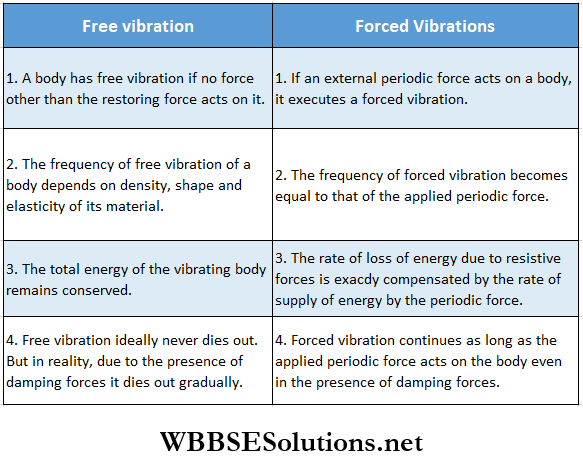
Nature Of Vibration – Resonance Or Resonant Vibration
Usually, when a body executes a forced vibration, its amplitude and velocity remain small. In most cases, the frequency of the applied periodic force does not come close to the natural frequency of the vibrating body.
- However, when the frequency of the applied periodic force becomes equal to the natural frequency of the body, the amplitude and the velocity of the body become very large. This phenomenon is called resonance.
- It is important to keep in mind that some objects are very resonant at a particular frequency while others barely resonate. For example, a temple bell will only ring at a fixed frequency, which is its resonant frequency but a lump of jelly will vibrate at many different frequencies but will not resonate at all.
Resonance Or Resonant Vibration Definition: When the frequency of the applied periodic force matches the natural frequency of a vibrating body, its amplitude rapidly increases to a large value. This phenomenon is called resonance.
This vibration is also known as sympathetic vibration. Resonant vibration is of two types.
Amplitude resonance: In this case, the amplitude of vibration becomes maximum. At amplitude resonance die frequency of applied force is slightly less than the natural frequency i.e., \(\omega=\sqrt{\omega_0^2-2 b^2}\)
Velocity resonance: In this case, the velocity of the vibrating body becomes maximum. Velocity resonance occurs when the natural frequency is exactly equal to the frequency of applied force i.e., ω = ω0.
Examples of resonance:
1. A thread is tied loosely between P and Q, and four simple pendulums C, D, E, and F are suspended from the thread. Pendulums C and D have the same length.
- So they have the same natural frequency. But the lengths of pendulums E and F are different from those of C and D. So they have different natural frequencies. Now if pendulum C is set into vibration, it executes SHM.
- Hence, a periodic force acts on the pendulums D, E, and F through the thread PQ. After a while, it is observed that, though E and p are set in forced vibration, their amplitudes and velocities of vibration are not large: but pendulum D vibrates with a large amplitude. This is because pendulum D resonates with pendulum C.
- As soon as pendulum D is set into resonant vibration, it applies, in mm, periodic forces on pendulums C F., and F through die thread PQ. This does not affect the vibrations of E and F very much, but pendulum C experiences resonance. In this wave, energy is alternately transferred from C to D and D to C.
- As a result, it is observed diet. when the amplitude of the vibration of pendulum C becomes very large, pendulum D almost comes to a stop; in die next moment the amplitude of pendulum D starts to increase while that of pendulum C gradually decreases.
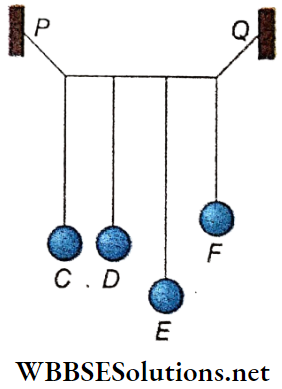
2. Resonant air column: The length of an air column contained in a tube determines die natural frequency of the column. If a vibrating tuning fork is held at the mouth of such a tube, forced vibration is set up in the air column.
- If the frequency of the tuning fork is the same as the natural frequency of the air column, then resonance occurs in the air column and a loud sound is heard. Using this phenomenon, sometimes a tuning fork is mounted on a hollow box.
- The box is so shaped that its frequency becomes equal to the natural frequency of the tuning fork. So, when the tuning fork is struck a resonance is produced and a loud sound is heard.
3. Hollow box in musical instruments: In musical instruments, such as violin, esraj, sitar, etc., the strings are stretched on a wooden hollow box or cavity The vibration of a string induces forced vibration on the wooden box and on a large mass of air inside it. This increases die intensity of die emitted sound. If resonance occurs die emitted sound is further intensified.
4. In musical instruments like violin, esraj, sitar, etc., there are a number of strings in addition to the principal string, which are adjusted or tuned to predefined notes of different frequencies.
When the principal string is played to produce a certain note, resonant vibrations may occur in some other string. This contributes to the increase in both the loudness and quality of the musical sound.
5. Helmholtz’s resonator: To detect the presence of tones of different frequencies in a note, the German scientist Helmholtz devised a resonator. It consists of a brass shell of nearly spherical shape with two openings a and b of different diameters.
- The natural frequency of die air inside the spherical shell depends on the size of the shell. The larger opening a, called hole or neck, is turned towards the source of sound while we place our ears in front of the smaller opening b, called pip.
- Now, suppose that in a note there is a tone whose frequency is equal to the natural frequency of the resonator. In that case, resonance is produced in the air inside the resonator and the tone will be heard distinctly. With the help of different resonators of known frequencies, we can detect different tones in a note.
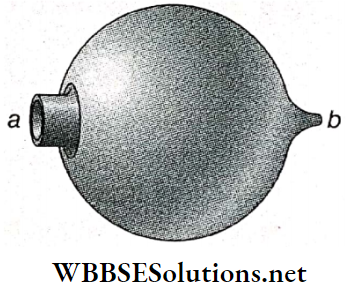
Comparison between Forced Vibration and Resonance
